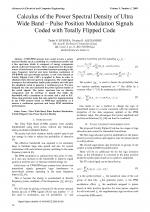| 1/2009 - 3 |
Calculus of the Power Spectral Density of Ultra Wide Band Pulse Position Modulation Signals Coded with Totally Flipped CodeDURNEA, T. N., ALEXANDRU, N. D. |
| Extra paper information in |
| Click to see author's profile in |
| Download PDF |
Author keywords
Ultra Wide Band, Pulse Position Modulation, Totally Flipped Code, Power Spectral Density
References keywords
systems(5), spectral(5), alexandru(4)
Blue keywords are present in both the references section and the paper title.
About this article
Date of Publication: 2009-02-03
Volume 9, Issue 1, Year 2009, On page(s): 16 - 21
ISSN: 1582-7445, e-ISSN: 1844-7600
Digital Object Identifier: 10.4316/AECE.2009.01003
Web of Science Accession Number: 000264815300003
SCOPUS ID: 67749111405
Abstract
UWB-PPM systems were noted to have a power spectral density (p.s.d.) consisting of a continuous portion and a line spectrum, which is composed of energy components placed at discrete frequencies. These components are the major source of interference to narrowband systems operating in the same frequency interval and deny harmless coexistence of UWB-PPM and narrowband systems. A new code denoted as Totally Flipped Code (TFC) is applied to them in order to eliminate these discrete spectral components. The coded signal transports the information inside pulse position and will have the amplitude coded to generate a continuous p.s.d. We have designed the code and calculated the power spectral density of the coded signals. The power spectrum has no discrete components and its envelope is largely flat inside the bandwidth with a maximum at its center and a null at D.C. These characteristics make this code suited for implementation in the UWB systems based on PPM-type modulation as it assures a continuous spectrum and keeps PPM modulation performances. |
| References | | | Cited By |
Web of Science® Times Cited: 2 [View]
View record in Web of Science® [View]
View Related Records® [View]
Updated today
SCOPUS® Times Cited: 3
View record in SCOPUS® [Free preview]
View citations in SCOPUS® [Free preview]
[1] Increasing the Performance of Energy-Detection Based UWB Demodulator with a Supplementary Integration Block, POPA, A., Advances in Electrical and Computer Engineering, ISSN 1582-7445, Issue 3, Volume 12, 2012.
Digital Object Identifier: 10.4316/aece.2012.03004 [CrossRef] [Full text]
[2] Accurate Analytical Multiple-Access Performance of Time-Hopping Biorthogonal PPM IR-UWB Systems, HERCEG, M., GRBIC, R., SVEDEK, T., Advances in Electrical and Computer Engineering, ISSN 1582-7445, Issue 2, Volume 11, 2011.
Digital Object Identifier: 10.4316/aece.2011.02010 [CrossRef] [Full text]
[3] A random pulse phase jitter technique for suppression of frequency spikes associated with UWB pulse position modulation, Aidong Yang, , Hui Qian, , Hong Nie, , Zhizhang Chen, , Lun Yu,, 2010 IEEE International Conference on Ultra-Wideband, ISBN 978-1-4244-5305-4, 2010.
Digital Object Identifier: 10.1109/ICUWB.2010.5615340 [CrossRef]
Disclaimer: All information displayed above was retrieved by using remote connections to respective databases. For the best user experience, we update all data by using background processes, and use caches in order to reduce the load on the servers we retrieve the information from. As we have no control on the availability of the database servers and sometimes the Internet connectivity may be affected, we do not guarantee the information is correct or complete. For the most accurate data, please always consult the database sites directly. Some external links require authentication or an institutional subscription.
Web of Science® is a registered trademark of Clarivate Analytics, Scopus® is a registered trademark of Elsevier B.V., other product names, company names, brand names, trademarks and logos are the property of their respective owners.
Faculty of Electrical Engineering and Computer Science
Stefan cel Mare University of Suceava, Romania
All rights reserved: Advances in Electrical and Computer Engineering is a registered trademark of the Stefan cel Mare University of Suceava. No part of this publication may be reproduced, stored in a retrieval system, photocopied, recorded or archived, without the written permission from the Editor. When authors submit their papers for publication, they agree that the copyright for their article be transferred to the Faculty of Electrical Engineering and Computer Science, Stefan cel Mare University of Suceava, Romania, if and only if the articles are accepted for publication. The copyright covers the exclusive rights to reproduce and distribute the article, including reprints and translations.
Permission for other use: The copyright owner's consent does not extend to copying for general distribution, for promotion, for creating new works, or for resale. Specific written permission must be obtained from the Editor for such copying. Direct linking to files hosted on this website is strictly prohibited.
Disclaimer: Whilst every effort is made by the publishers and editorial board to see that no inaccurate or misleading data, opinions or statements appear in this journal, they wish to make it clear that all information and opinions formulated in the articles, as well as linguistic accuracy, are the sole responsibility of the author.



